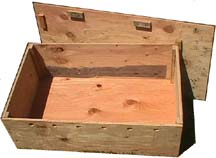
Planning a worm bin
 Binet Payne's worm bins are
as simple as you can get, but using her figures you can make a worm bin
as fancy as you please. When designing your worm bin, plan to
keep it pretty shallow --- twelve inches deep worked well for her ---
and to provide one cubic foot of bin space per pound of daily food
waste. A family that produces a pound or two of food waste per
day can get away with a 2 cubic foot worm bin (2 feet by one foot by
one foot), but Binet Payne's school produces perhaps ten times that
amount of food waste per day so she built her bins to be about 32 cubic
feet.
Binet Payne's worm bins are
as simple as you can get, but using her figures you can make a worm bin
as fancy as you please. When designing your worm bin, plan to
keep it pretty shallow --- twelve inches deep worked well for her ---
and to provide one cubic foot of bin space per pound of daily food
waste. A family that produces a pound or two of food waste per
day can get away with a 2 cubic foot worm bin (2 feet by one foot by
one foot), but Binet Payne's school produces perhaps ten times that
amount of food waste per day so she built her bins to be about 32 cubic
feet.
The most basic worm bin
is simply a wooden frame made of 2X12s with a plywood bottom and
lid. To keep costs low, Binet made her bins 8 feet by 4 feet, so
each one used three pieces of lumber for the sides and one full sheet
of plywood for the top and another for the bottom. She warns not
to use treated wood, but she didn't find any problems when using cedar
to extend the life of her worm bin.
 Binet's bins were propped up
on railroad ties or cinderblocks to provide a bit of air space
underneath, and she drilled half inch holes every nine inches along the
width of the bottom and every 18 inches along the length. In my
own experience, I've found that the worm tea is the most valuable
byproduct of vermiculture, so I'd add some sort of collection basin
underneath to capture any liquid that seeps out the holes. Lay a
sheet of black plastic on top of the bin contents below the plywood
lid, and your quick and dirty bin is complete.
Binet's bins were propped up
on railroad ties or cinderblocks to provide a bit of air space
underneath, and she drilled half inch holes every nine inches along the
width of the bottom and every 18 inches along the length. In my
own experience, I've found that the worm tea is the most valuable
byproduct of vermiculture, so I'd add some sort of collection basin
underneath to capture any liquid that seeps out the holes. Lay a
sheet of black plastic on top of the bin contents below the plywood
lid, and your quick and dirty bin is complete.
For those of you who
have gone beyond the under-the-sink worm bin scale, what does your bin
look like? I'd love to hear from anyone who's built a bin that
keeps the worms happy, collects compost tea, and is still cheap to put
together.
| This post is part of our Worm Cafe lunchtime series.
Read all of the entries: |
Want more in-depth information? Browse through our books.
Or explore more posts by date or by subject.
About us: Anna Hess and Mark Hamilton spent over a decade living self-sufficiently in the mountains of Virginia before moving north to start over from scratch in the foothills of Ohio. They've experimented with permaculture, no-till gardening, trailersteading, home-based microbusinesses and much more, writing about their adventures in both blogs and books.
Want to be notified when new comments are posted on this page? Click on the RSS button after you add a comment to subscribe to the comment feed, or simply check the box beside "email replies to me" while writing your comment.

That's not a dumb question at all. Worms can give you added value over a compost pile in a few ways, but as you can tell by our relatively worm-less farm, we've made do without them. Here are a few of the top benefits of using worms over traditional composting:
Here are a few of the top benefits of using worms over traditional composting:
*Worms can expedite the compost process and give you more organic matter faster.
*It's often easier to build a worm bin that allows you to collect the valuable worm tea than to build a compost bin that lets you collect compost tea.
*If you plan it right, you can feed your excess worms to your chickens, giving them a very healthy, high protein food source.
*Worm castings are probably the best compost imaginable. The only other compost that I think compares is stump dirt. Especially if you keep potted plants, the castings are as good as gold and ten times better than run of the mill compost.
*People like worms. This is actually the real reason I'm thinking of using worm bins with local schools. Except for gardeners, compost is just considered rotting food waste, but add in worms and you catch people's attention. They're not quite charismatic megafauna, but they're the composter's equivalent.
I'm planning to set up some worm towers, pretty much the same as these ones:
http://milkwood.net/2010/10/12/how-to-make-a-worm-tower/
You can't really harvest the worm tea or castings, but the worms are distributing them through your garden beds right where you need them anyway.
Anna,
You've yet to hear of someone who has found a cheap option that works? I need to show you my bins next time you're over here. They are cheap, durable, the worms like them, and I collect the tea. All it takes is a few of those ubiquitous plastic storage bins and a drill bit. The trick to mine that I haven't seen others use is that I have a bin on the bottom without any holes, which catches the tea. But you have to put something down in there (I use an old cat-food dish that's 4 inches high) to keep the top bins (the ones with holes) high enough that the water can drain.
Any experience with old fridges?
I'm trying one out. Mainly using it for insulation against extreme heat and cold. I think the cold killed my worms last winter : (
Anna,
There's a link to the video in my signature on this comment.
You are right about the scalability thing, although I think these have more capacity than the worm towers do. When my first one got full I just started another. I have two full ones now and will probably need a third, but three of them would be more than enough for us all year in rotation. I tend to put more food in these than in our compost piles because they're closer to the house.
The worms just keep multiplying. I can bring some red wrigglers next time we get together. They'd replace themselves in a few months easily.
Everett ---
I'm pretty sure this comment is by you even though it's signed as "Anna"?
Now that I see your video, I realize that's what we based our indoors worm bin design on. It does seem to work well for the small scale, but I'm looking for something that would be much larger and work with cafeteria waste from the nearby school. For anyone reading this who's thinking of making a home bin, go watch Everett's video! This is a very cheap and easy way to make a family-size bin.
I'd love some worm starts next time we see you! I managed to kill mine this summer with improper bedding...